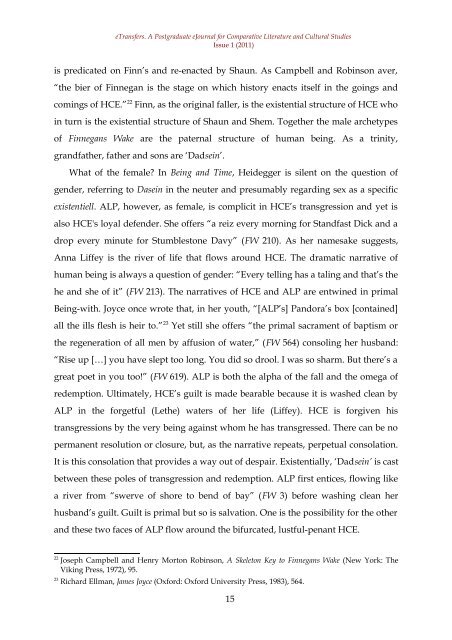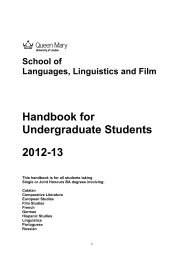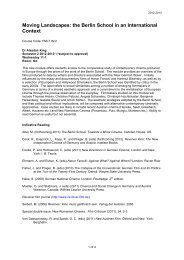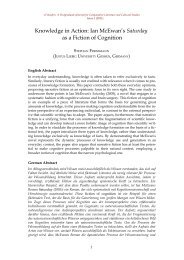Finnegans Wake - Queen Mary, University of London
Finnegans Wake - Queen Mary, University of London
Finnegans Wake - Queen Mary, University of London
Create successful ePaper yourself
Turn your PDF publications into a flip-book with our unique Google optimized e-Paper software.
eTransfers. A Postgraduate eJournal for Comparative Literature and Cultural Studies<br />
Issue 1 (2011)<br />
is predicated on Finn’s and re-enacted by Shaun. As Campbell and Robinson aver,<br />
“the bier <strong>of</strong> Finnegan is the stage on which history enacts itself in the goings and<br />
comings <strong>of</strong> HCE.” 22 Finn, as the original faller, is the existential structure <strong>of</strong> HCE who<br />
in turn is the existential structure <strong>of</strong> Shaun and Shem. Together the male archetypes<br />
<strong>of</strong> <strong>Finnegans</strong> <strong>Wake</strong> are the paternal structure <strong>of</strong> human being. As a trinity,<br />
grandfather, father and sons are ‘Dadsein’.<br />
What <strong>of</strong> the female? In Being and Time, Heidegger is silent on the question <strong>of</strong><br />
gender, referring to Dasein in the neuter and presumably regarding sex as a specific<br />
existentiell. ALP, however, as female, is complicit in HCE’s transgression and yet is<br />
also HCE's loyal defender. She <strong>of</strong>fers “a reiz every morning for Standfast Dick and a<br />
drop every minute for Stumblestone Davy” (FW 210). As her namesake suggests,<br />
Anna Liffey is the river <strong>of</strong> life that flows around HCE. The dramatic narrative <strong>of</strong><br />
human being is always a question <strong>of</strong> gender: “Every telling has a taling and that’s the<br />
he and she <strong>of</strong> it” (FW 213). The narratives <strong>of</strong> HCE and ALP are entwined in primal<br />
Being-with. Joyce once wrote that, in her youth, “[ALP’s] Pandora’s box [contained]<br />
all the ills flesh is heir to.” 23 Yet still she <strong>of</strong>fers “the primal sacrament <strong>of</strong> baptism or<br />
the regeneration <strong>of</strong> all men by affusion <strong>of</strong> water,” (FW 564) consoling her husband:<br />
“Rise up […] you have slept too long. You did so drool. I was so sharm. But there’s a<br />
great poet in you too!” (FW 619). ALP is both the alpha <strong>of</strong> the fall and the omega <strong>of</strong><br />
redemption. Ultimately, HCE’s guilt is made bearable because it is washed clean by<br />
ALP in the forgetful (Lethe) waters <strong>of</strong> her life (Liffey). HCE is forgiven his<br />
transgressions by the very being against whom he has transgressed. There can be no<br />
permanent resolution or closure, but, as the narrative repeats, perpetual consolation.<br />
It is this consolation that provides a way out <strong>of</strong> despair. Existentially, ‘Dadsein’ is cast<br />
between these poles <strong>of</strong> transgression and redemption. ALP first entices, flowing like<br />
a river from “swerve <strong>of</strong> shore to bend <strong>of</strong> bay” (FW 3) before washing clean her<br />
husband’s guilt. Guilt is primal but so is salvation. One is the possibility for the other<br />
and these two faces <strong>of</strong> ALP flow around the bifurcated, lustful-penant HCE.<br />
22 Joseph Campbell and Henry Morton Robinson, A Skeleton Key to <strong>Finnegans</strong> <strong>Wake</strong> (New York: The<br />
Viking Press, 1972), 95.<br />
23 Richard Ellman, James Joyce (Oxford: Oxford <strong>University</strong> Press, 1983), 564.<br />
15







